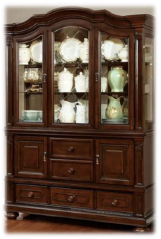Before Anne moved from her single-family home to her townhouse, she measured all of the rooms carefully and was delighted to find that all of her furniture fit. But when she and her husband moved in, reality struck. The style of the 45-year-old house was very different from the style of the new upscale townhouse, and the living and dining room furniture looked out of place. They sold two armchairs, gave away a couch, and decided to live with the dining room suite. Three years later, their son decided he wanted the dining room table and chairs, but not the buffet, china cabinet, or cutlery chest. Anne and Charles were excited to get a new table and chairs. They didn’t know what to do with the other pieces of the set. The solid mahogany dining room suite was given to them by Anne’s parents, and it came from her family home. She was very conflicted between disposing of a family treasure and addressing the reality of their new home and space.
The china cabinets and hutches of the 1960s are big and challenging to accommodate in many homes. When Anne tried to sell the hutch, or even donate it, she found that there are lots of them on the market, and very few people want them. The only option was to take hers to a furniture recycling depot, and she did so with a very heavy heart.
This is such a common concern. Furniture styles have changed, and spaces in homes are used differently from how they were years ago. Modern homes need modern furniture, or a carefully crafted mix of styles. That is the practical side. On the emotional side, many of us feel obligated to find a place for a large item given to us, even when it doesn’t really fit or suit. Is this realistic? Is it reasonable?
If you think something is an antique, check its age. If it is older than 100 years, it likely qualifies. More than 40 years old, it is “vintage”. Some can be classified as “mid-century modern”. There is also just plain “old”. And if you’re getting rid of something, it has to be beautiful, in good condition, and someone has to want it.

Some creative ideas that we found may provide some solutions.
Roy was given a chest of drawers by his great aunt. It was beautiful, but he didn’t need it or have a place for it. He eventually put it in the garage, lined each drawer with shelf liner, and used it for vegetables – potatoes, carrots, onions. Not the intended use for a dresser, but one that worked.
Alicia wanted her grandmother’s dresser, and when it arrived at her home, she realized how massive it was. With the help of her father, they removed the centre section and created two small tables with 3 drawers each – perfect for night tables. A coat of black paint made them gleam and made Alicia smile!
Simon’s massive oak desk weighed around 350 pounds and had been the focal point of his office for decades. When Simon and his wife Edie moved into a retirement home, his 17-year- old grandson, Stefan, asked if he could have the desk, and Simon was delighted. Getting it out of the home office and into Stefan’s room at his home was a challenge that took 3 movers to solve. Stefan eventually accepted that the desk was taking up an inordinate amount of space in his bedroom. His father suggested that it would make a beautiful table, so they took the two filing cabinet pedestals off, removed the centre drawer, and purchased some wood for legs. They refinished the top to make a gorgeous and timeless dining table which now, many years later, Stefan and his wife enjoy in their home.
Remember those old pianos that many people learned to play on? Massive, heavy, and hard to keep in tune? Bev was sure hers was worth a lot of money, so she posted it for sale online, and she was sure she would get several thousand dollars for it. Six long months later she found a musical theatre group that agreed to accept it as a donation and as a bonus, picked it up from her home.
These are just a few examples and a few ideas. New paint and handles can give old pieces new life. Recovering chairs and benches with modern fabric is easy and effective. Secondhand furniture stores take some items on consignment. And there is always the recycling depot…
Some styles of furniture are more timeless and less subject to the vogues of the day. Interior designers will sometimes create a space by starting with one signature piece and building the rest of the feel of the room around it. If a piece has charm and personality, you may be able to develop a room design around it. A collectible item, or a curio, could be staged as a focal point. Matching isn’t as important as coordinating and can be more visually interesting. Unconventional uses and personalized tweaks can make the old new again.
If you can give a piece a new life, great. If not, don’t be saddled with something that you don’t want, don’t need, or can’t easily accommodate. That chair that your grandmother left you is just a chair, not a human. You’ll likely feel lighter and better if you let it go.
